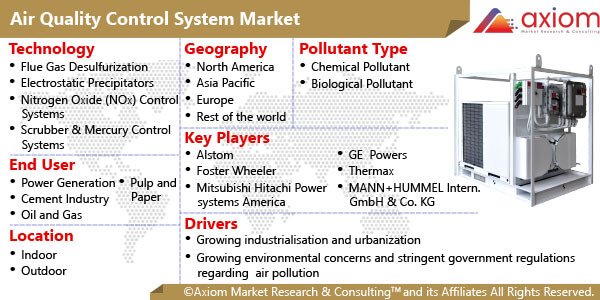Air pollution has been a worldwide problem. The growing industrialization, burning of fossil fuels, mining operations and changing lifestyles increases the amount of toxic pollutants in the air. Growing air pollution is a major and increasing threat to the public health. Air quality control system helps for monitoring and controlling the gases and pollutants in the air and helps to release the clean and safe air. The system helps the power plants, manufacturing areas, and industrial premises to reach the stringent environmental protection regulations.
Air Quality Control System Market Outlook
The growing industrialisation and increasing use of vehicles has led to increase in the emission of exhaust gases and toxic air pollutants. The increasing air pollution impacts positively on the demand of air quality control system market. The growing environmental concern and stringent government regulations regarding the air pollution boosts the demand of air quality control system.
Air Quality Control System Market Segmental Overview
The study analyses the global air quality control system market based on technology, application, and geography.
Air Quality Control System Market by Technology
By technology, the air quality control system is bifurcated into flue gas desulfurization, electrostatic precipitators, nitrogen oxide control system, selective catalyst reduction system, and others.
Air Quality Control System Market by Application
Major applications of the air quality control system covered in the study are power generation, cement industry, oil and gas, biomass, pulp and paper, iron & steel industry, chemical industry and others. Power generation sector contribute the major share in the growth of air quality control system. The coal based power plants are the biggest source of air pollution from the power plants. It emits large amount of toxic pollutants like SO2, NOx, and CO in the air. The production and impact of these harmful gases can be reduces by using the air quality control system like scrubbers, flue gas desulfurizers and electrostatic precipitators.
Air Quality Control System Market by Key Player
The key competitors of the air quality control system market are Alstom (France), Babcock & Wilcox Company (U.S.), Foster Wheeler (U.S.), Mitsubishi Hitachi Power systems America (Japan), Hamon RC (U.S.), KBR (U.S), and Siemens Energy (Germany) among others.
Air Quality Control System Market by Geography
Geographically, the study is comprised of the key countries of North America, Europe, Asia-Pacific and the Rest of the World. Asia Pacific held the largest market share of the air quality control system market. The increasing growth of industrial sector in the region fuels the use of coal combustion and mining operations, which boosts the demand of air quality control system in Asia Pacific. The stringent government regulations regarding the growing air pollution in the countries like China and India also supports the growth of air quality control system market in the region.











